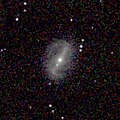NGC 6217
| NGC 6217 | |
|---|---|
 NGC 6217 photographed by the Hubble Space Telescope | |
| Observation data (J2000 epoch) | |
| Constellation | Ursa Minor |
| Right ascension | 16h 32m 39.217s[1] |
| Declination | +78° 11′ 53.56″[1] |
| Redshift | 0.004543 ± 0.000013[2] |
| Heliocentric radial velocity | 1,368[3] km/s |
| Distance | 67.2 Mly (20.6 Mpc)[3] |
| Apparent magnitude (V) | 11.2[4] |
| Characteristics | |
| Type | (R)SB(rs)bc[5] |
| Apparent size (V) | 55,000 light years |
| Other designations | |
| ARP 185, UGC 10470[2][6] | |
NGC 6217 is a barred spiral galaxy located some 67 million light years away,[3] in the constellation Ursa Minor. It can be located with a 10 cm (4 in) or larger telescope as an 11th magnitude object about 2.5° east-northeast of the star Zeta Ursae Minoris.[4] The galaxy is inclined by an angle of 33° to the line of sight along a position angle of 162°.[3]
A morphological classification of (R')SB(rs)bc[5] indicates that NGC 6217 has a false outer ring-like structure formed from the spiral arms (R'), a well-defined bar running across the nucleus (SB), a partial inner ring (rs), and moderately-wound spiral arms (bc).[7] The nucleus is spherical in shape, showing no indication of oblateness.[5] The prominent bar spans an angular distance of 48″ (48 arc seconds) across the galaxy along a position angle of 35.97° ± 0.35°. At 10″ southeast of the nucleus is a prominent region of star formation. The inner ring is about 43″.5 across.[8]
NGC 6217 has been characterized as a starburst galaxy, which means it is undergoing a high rate of star formation compared to a typical galaxy. As a result, the spectrum is dominated by stellar photoionization from young, hot stars.[9] This component is less than 10 million years old, producing a blue-hued spectral continuum with absorption weak lines from elements other than hydrogen and helium.[6] At the core of the galaxy is a low-luminosity active galactic nucleus which has formed an H II region.[10]
One supernova has been observed in NGC 6217: SN 2018gj (Type II, mag 14.4).[11]
Gallery
References
- ^ a b Skrutskie, Michael F.; Cutri, Roc M.; Stiening, Rae; Weinberg, Martin D.; Schneider, Stephen E.; Carpenter, John M.; Beichman, Charles A.; Capps, Richard W.; Chester, Thomas; Elias, Jonathan H.; Huchra, John P.; Liebert, James W.; Lonsdale, Carol J.; Monet, David G.; Price, Stephan; Seitzer, Patrick; Jarrett, Thomas H.; Kirkpatrick, J. Davy; Gizis, John E.; Howard, Elizabeth V.; Evans, Tracey E.; Fowler, John W.; Fullmer, Linda; Hurt, Robert L.; Light, Robert M.; Kopan, Eugene L.; Marsh, Kenneth A.; McCallon, Howard L.; Tam, Robert; Van Dyk, Schuyler D.; Wheelock, Sherry L. (1 February 2006). "The Two Micron All Sky Survey (2MASS)". The Astronomical Journal. 131 (2): 1163–1183. Bibcode:2006AJ....131.1163S. doi:10.1086/498708. ISSN 0004-6256. S2CID 18913331.
- ^ a b "NGC 6216", NASA/IPAC Extragalactic Database, retrieved 2013-06-20.
- ^ a b c d Gusev, A. S.; et al. (August 2012), "Oxygen and nitrogen abundances of H II regions in six spiral galaxies", Monthly Notices of the Royal Astronomical Society, 424 (3): 1930–1940, arXiv:1205.3910, Bibcode:2012MNRAS.424.1930G, doi:10.1111/j.1365-2966.2012.21322.x, S2CID 118437910.
- ^ a b O'Meara, Stephen James (2007), Steve O'Meara's Herschel 400 Observing Guide, Cambridge University Press, p. 227, ISBN 978-0521858939.
- ^ a b c Ann, Hong Bae (December 2003), "CCD Surface Photometry of Spiral Galaxies: Bulge Morphology", Journal of the Korean Astronomical Society, 36 (4): 261–270, Bibcode:2003JKAS...36..261A, doi:10.5303/jkas.2003.36.4.261.
- ^ a b Cid Fernandes, Roberto; González Delgado, Rosa M.; Schmitt, Henrique; Storchi-Bergmann, Thaisa; Martins, Lucimara P.; Pérez, Enrique; Heckman, Timothy; Leitherer, Claus; Schaerer, Daniel (April 2004), "The Stellar Populations of Low-Luminosity Active Galactic Nuclei. I. Ground-based Observations", Astrophysical Journal, 605 (1): 105–126, arXiv:astro-ph/0401416, Bibcode:2004ApJ...605..105C, doi:10.1086/382217, S2CID 119101213.
- ^ Buta, Ronald J.; et al. (2007), Atlas of Galaxies, Cambridge University Press, pp. 13–17, ISBN 978-0521820486.
- ^ Cabrera-Lavers, A.; Garzón, F. (March 2004), "An Optical Study of a Sample of Spiral Galaxies", The Astronomical Journal, 127 (3): 1386–1404, Bibcode:2004AJ....127.1386C, doi:10.1086/381924.
- ^ Elfhag, T.; et al. (February 1996), "A CO survey of galaxies with the SEST and the 20-m Onsala telescope", Astronomy and Astrophysics Supplement, 115: 439–468, Bibcode:1996A&AS..115..439E.
- ^ Véron-Cetty, M.-P.; Véron, P. (July 2010), "A catalogue of quasars and active nuclei", Astronomy and Astrophysics, 518 (13th ed.): A10, Bibcode:2010A&A...518A..10V, doi:10.1051/0004-6361/201014188.
- ^ Transient Name Server entry for SN 2018gj. Retrieved 5 January 2023.
External links
 Media related to NGC 6217 at Wikimedia Commons
Media related to NGC 6217 at Wikimedia Commons- "Hubble Opens New Eyes on the Universe", Hubble Site news Center, NASA, September 9, 2009, retrieved 2013-06-18
- "NGC 6217". SIMBAD. Centre de données astronomiques de Strasbourg. Retrieved 2013-06-20.

